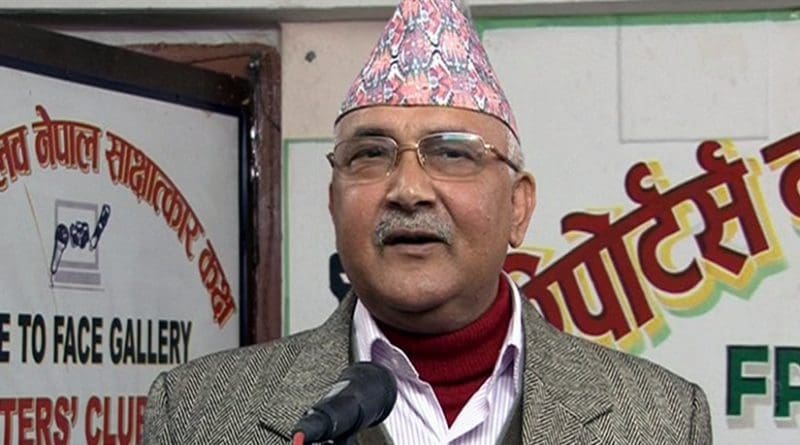Contextualising KP Oli’s India And China Visits – Analysis
By IPCS
By Pramod Jaiswal*
Nepal has traditionally played India against China to maximise its benefits. Has Nepalese Prime Minister Khadga Prasad (KP) Sharma Oli been doing the same? How?
Prime Minister Oli paid his first foreign visit to New Delhi before visiting Beijing. During his India visit, Oli signed a wide range of agreements on economic cooperation, transit facilities, and energy-sharing. Some of the major agreements signed between India and Nepal were related to transit facilities and connectivity. They include, Nepal-Bangladesh transit via the Kakadbhitta–Banglabandha (Nepa-Bangladesh) corridor; strengthening of the postal highway in Nepal’s Tarai region; and transit facilities for Nepal through India’s Vishakhapatnam port. Furthermore, India also agreed to supply electricity through the Muzaffarpur-Dhalkebar transmission line to the energy-starved Nepal.
Similarly, during his visit to China, Oli signed agreements related to infrastructure development, such as constructing the bridge over Karnali River at Hilsa; constructing oil storage facilities; carrying out a feasibility study on oil and gas resources in Nepal; feasibility study of railway and construction of Nepal’s Pokhara International Airport. However, Oli’s visit was seen as more symbolic and less substance because most of the agreements signed were a reiteration of past agreements.
Nepal being landlocked and dependent on India for transit and connectivity, signed multiple agreements on those with India because such connectivity via China is unfeasible due to poor infrastructure and difficult terrain in northern Nepal. However, Kathmandu sought development and infrastructure projects from Beijing because of China’s ability to deliver high quality infrastructure on time at lower costs. Similarly, Chinese projects perceived to have fewer strings attached because after the completion of the projects, the Chinese leave without playing much with Nepal’s internal politics.
Both India and China committed assistance towards the reconstruction of earthquake affected zones in Nepal. With Beijing, Kathmandu signed an agreement to open a Nepalese consulate in Guangzhou; China agreed to study Nepal’s proposal of establishing a consulate in Chengdu. As reciprocity, Nepal might agree to China’s proposal of opening its consulate in Pokhara. However, India will not view it favourably as it could have strategic implications.
The most criticised agreement between India and Nepal was the one on transit facilities to Nepal through India’s Vishakhapatnam port. Experts from both countries argued that such a facility was not feasible because Nepal already has access to Kolkata port which is less than 1000 kilometers from the former. Conversely, Vishakhapatnam port is approximately 2000 kilometers from Nepal. As both Kolkata and Vishakhapatnam ports lie on the eastern coast, it would have been beneficial for Nepal to seek access through India’s western coasts. There was similar criticism on sea access via the Chinese port of Tianjin, as its located 3000 kilometers from Nepal. However, in terms of cost-efficiency, Vishakhapatnam port is more beneficial than Tianjin port.
Likewise, the agreement on the feasibility study for extending Chinese railway lines into Nepal was much hyped by the Indian media and security experts. Most reports were highly exaggerated, stating that a China-Nepal agreement to link Lhasa with Kathmandu and further to Lumbini, has already been signed. Though the Indian media had exaggerated and were apprehensive about Oli’s China visit, eminent scholars like SD Muni and former Indian Foreign Secretary Shyam Saran stated that India need not worry about Oli’s China card citing that Oli and Kathmandu’s elite wanted to divert their domestic tensions regarding the Madhes issue with the China card.
Why did Oli visit India and China, despite the fact that he would not be able to garner much from the visits? It was because both Oli and India wanted to normalise the New Delhi-Kathmandu relationship that had been strained due to the ‘unofficial blockade’ at the border. Oli also used the visit as a bargaining tool for easing the movement of goods through the India-Nepal border. He insulated himself and his party from upsetting relations with India by not breaking the traditional trend of visiting New Delhi before Beijing. Barring Prachanda, all Nepalese prime ministers have visited India before China. However, despite the grand welcome by Delhi and end of ‘unofficial blockade’, India did not sign a joint statement with Nepal in order to pressurise Oli to resolve the Madhes issue via negotiating with the agitating parties. Consequently, Oli attempted to exploit his China visit to challenge Indian ‘interference’. He invited Chinese presence in Nepal with a view to assist the latter in gradually minimising its dependence on India.
These two visits will have limited impact on Nepal and India does not have much to worry about vis-à-vis Oli’s China visit. India has tremendous influence in Nepal and none of the agreements with China can cause an immediate threat to New Delhi. However, Chinese presence and influence in Nepal, as in other South Asian countries, is rising; and India should be prepared to deal with it.
Chinese railway lines will reach the Nepal border and beyond in a decade. Beijing’s ambitions are evident via its ‘One Belt, One Road’ initiative. If Oli’s tenure lasts, the China-Nepal engagement might develop at a greater pace. However, to ensure greater economic benefits from India, China might hesitate to challenge India’s dominant position in Nepal. Similarly, Beijing might not open Tibet up through Nepal until the situation normalises inside Tibet and Nepal becomes stable.
* Pramod Jaiswal
Senior Research Officer, IReS, IPCS
E-mail: [email protected]

